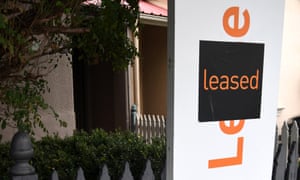Report estimates up to 1 million people may be in rental debt as end of Covid-spurred moratoriums on eviction approaches
Hundreds of thousands of renters could face eviction when moratoriums end around Australia, an advocacy group’s new report says.
In the report, released on Wednesday, Better Renting analysed publicly available data on rent deferrals and negotiations to estimate how many tenants are experiencing rental debt throughout Australia.
The group estimated 5% to 15% of tenants Australia-wide may be in rental debt, which would equate to 324,000 to 973,000 people, it said.
According to the low-end estimate, that would mean 106,000 people in New South Wales, 84,000 in Victoria, 73,000 in Queensland, 30,000 in Western Australia and 19,000 in South Australia were in rental debt. The ACT and Tasmania were estimated to have 5,000 people in rental debt each and the Northern Territory 3,000.
“These are people who could lose their current home if they remain in rental debt and landlords begin issuing termination notices as moratoriums are lifted,” the report said.
The estimates drew on data from Better Renting’s own surveys and other data from the Australian National University, Ahuri, the University of NSW, the Consumer Policy Research Centre and the property management platform MRI. Overall, Better Renting said it analysed survey data from 20,000 renters.
Eviction moratoriums were put in place in all states and territories to varying degrees from the start of the pandemic but the safeguards are now being withdrawn.
Queensland ended protections for residential tenants on 30 September, while moratoriums in other states will end early next year, mostly in March.
The potential rent bomb stems from tenants who were unable to secure rent reductions in negotiations with their landlords. Instead, they received a rent deferral, meaning debt continued to accrue.
A previous survey by the Better Renting group found only 9% of the 1,000 renters surveyed asked for and received a “satisfactory” rent reduction.
Citing research from the Consumer Policy Research Centre, the Better Renting report argued there were other tenants who did not owe their landlord but had “debt in the mailbox”. That meant they had prioritised paying their rent but had instead racked up debts to credit card or utilities companies.
The Consumer Policy Centre found two in five renters have credit card debt or debt to a “buy now pay later” company.
Joel Dignam, the executive director at Better Renting, said governments had a “responsibility to do something about this threat”.
He blamed the situation on “government inaction and property investors refusal to provide rent reductions” and called on governments to “acquire the debt from landlords”.
No state government has so far indicated an intention to go any further than the moratoriums and rental grants that have been offered in some states.
The Better Renting report also noted there was “inadequate government monitoring of rental debt”.
It said governments should collate statistics on the processing of bond submissions and refunds, the nature of cases reaching tribunals, the quantity and type of lease terminations, and the quantum of rental debt.
Guardian Australia reported in July that despite the approach of a financial cliff for renters, even the federal government was unaware of how many renters were accruing a liability, how many were behind in their rent and how many had managed to negotiate a cut.

No comments:
Post a Comment